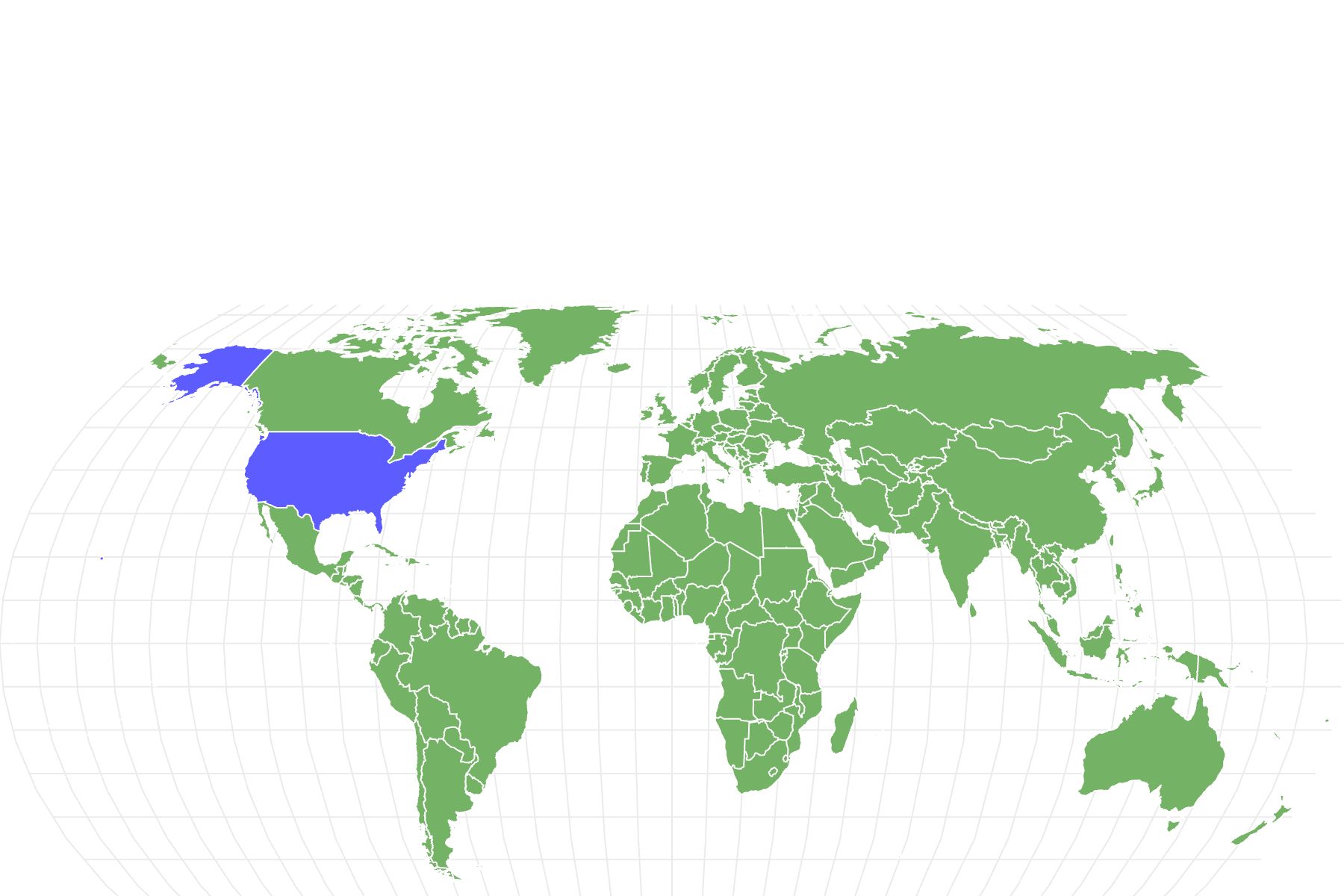Redbone Coonhound
Canis lupus
Originally bred to track raccoons.
Advertisement
Redbone Coonhound Scientific Classification
- Kingdom
- Animalia
- Phylum
- Chordata
- Class
- Mammalia
- Order
- Carnivora
- Family
- Canidae
- Genus
- Canis
- Scientific Name
- Canis lupus
Read our Complete Guide to Classification of Animals.
Redbone Coonhound Conservation Status
Redbone Coonhound Facts
- Diet
- Omnivore
Redbone Coonhound as a Pet:
- General Health
- Energy Level
- Shedability
- Trainability
- Intelligence
- Tendency to Chew
- Size
- Family and kid friendliness
- Yappiness / Barking
- High
- Separation Anxiety
- High
- Preferred Temperature
- Average climate
- Exercise Needs
- High
- Friendly With Other Dogs
- High
- Pure bred cost to own
- $500-$800 for a puppy.
- Dog group
- Hound
- Male weight
- 45-70 lbs
- Female weight
- 45-70 lbs
This post may contain affiliate links to our partners like Chewy, Amazon, and others. Purchasing through these helps us further the A-Z Animals mission to educate about the world's species.
View all of the Redbone Coonhound images!
Incredibly vocal, the Redbone Coonhound’s voice can be a sweet tune in areas that won’t be disrupted by their frequent noise.
The Redbone Coonhound dates back to colonial days, but it has since made its way into the hearts of many households. With a loud bark and an energetic disposition, it is easy to tell when this breed is around. They won’t need much maintenance, but they crave tons of mental and physical stimulation from their owners.
See all of our expert product reviews.
As helpful as a few fun facts can be, they don’t tell the entire reality of bringing a Redbone Coonhound home. Here are a few pros and cons to consider before adoption.
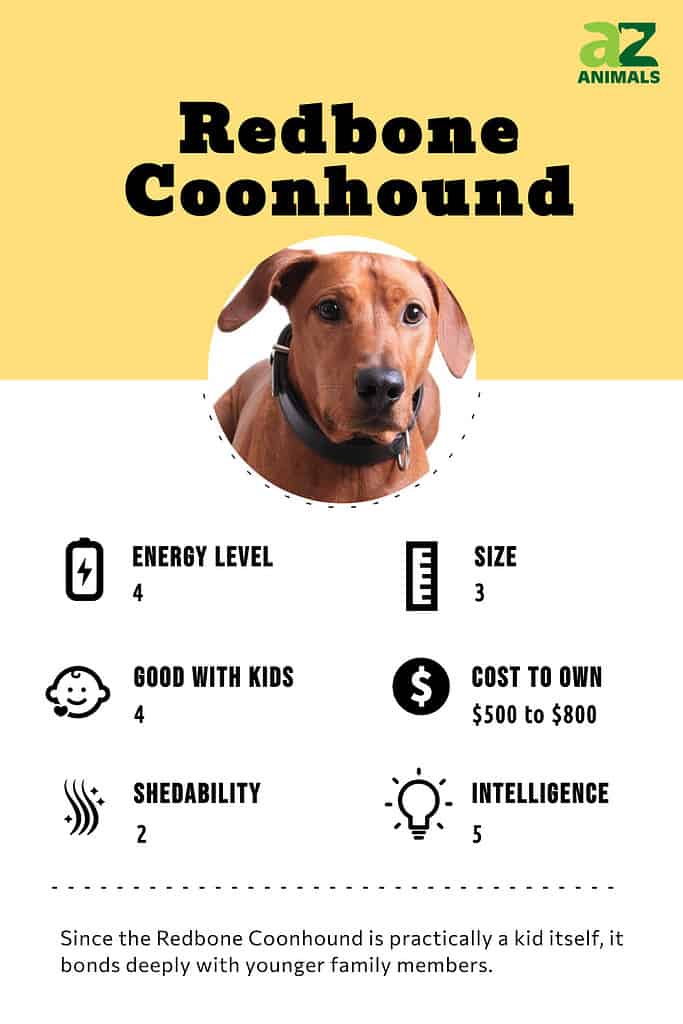
3 Pros and Cons of Owning a Redbone Coonhound
| Pros! | Cons! |
|---|---|
| Minimal shedding: While the Redbone Coonhound is not hypoallergenic by any means, it won’t have nearly the same shedding as similar breeds do. | Highly energetic: This dog needs to get a lot of opportunity for physical exercise, so it may not be suitable to individuals that can’t match this active lifestyle. |
| Great with kids: Since the Redbone Coonhound is practically a kid itself, it bonds deeply with younger family members. | Loves to bark: Redbone Coonhounds tend to sing a fairly happy song when they are hunting, but these noises aren’t so pleasant for neighbors that don’t share their same temperament. |
| Friendly to other animals: For any home that already has some dogs, this breed can integrate rather well with some time to socialize. | Takes some time to train: The mental and physical development of the Redbone Coonhound is slow, so simple commands may take longer to learn. |
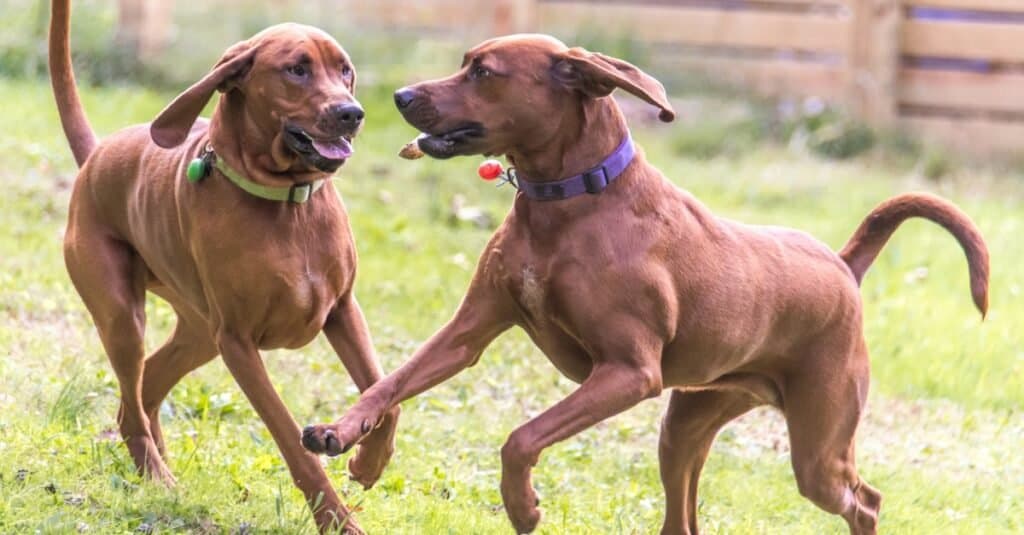
The Redbone Coonhound can integrate well into any home that already has dogs.
©Marcello Sgarlato/Shutterstock.com
Evolution and Origins
The Redbone Coonhound was originally brought to the Colonies by Scottish and Irish immigrants. Though the breed itself is American, the Redbone Coonhound is genetically derived from Bloodhounds and Foxhounds.
Size and Weight
Though the stands of the Redbone Coonhound are rather large, the males and females differ slightly. Typically, the male of the breed is larger, standing at 22 to 27 inches tall, measuring from the foot to the shoulder. Females, on the other hand, only measure 21 to 25 inches tall at this same spot. Regardless of gender, the Redbone Coonhound ranges from 45-70 lbs when it has reached adulthood.
Health and Entertainment for your Redbone Coonhound
See all of our expert product reviews.
| Height (Male) | 22-27 inches tall (to the shoulder) |
| Height (Female) | 21-25 inches tall (to the shoulder) |
| Weight (male) | 45-70 lbs, fully grown |
| Weight (female) | 45-70 lbs, fully grown |
Common Health Issues
Anyone who adopts a Redbone Coonhound from a rescue or a breeder will be happy to learn that they are rather healthy animals. Due to their long legs, hip dysplasia is one of the most common issues that they’ll come up against. Luckily, the risk is low, though it can cost up to $6,000 to correct. Always check with breeders that can show a medical history of the parents of the puppy, including ratings from the Orthopedic Foundation for Animals and the Canine Eye Registry Foundation.
Others can injure their legs as a result of their energetic jumping and running while hunting. Even coming up against a critter during these escapades can cause a lot of harm. Always lookout for a limp or bite after hunting, no matter how slight, and seek out veterinary care immediately.
The floppy ears are a trademark of the Redbone Coonhound, but therein lies another possible health issue: ear infections. Luckily, checking the ears weekly for buildup, mites, and ticks are easy ways to prevent these issues.
Since this dog has such an affinity for good flavors and aromas, one of the other concerns is obesity. Feeding a healthy and steady diet to your pup can make a big difference in preventing this problem, though a treat here and it is safe.
Putting a dog through genetic testing can answer most potential health questions for their future. Plus, with regular care, the lifespan of the Redbone Coonhound typically ranges from 12-14 years. Overall, you should look out for:
- Hip dysplasia
- Physical injuries
- Ear infections
- Obesity.
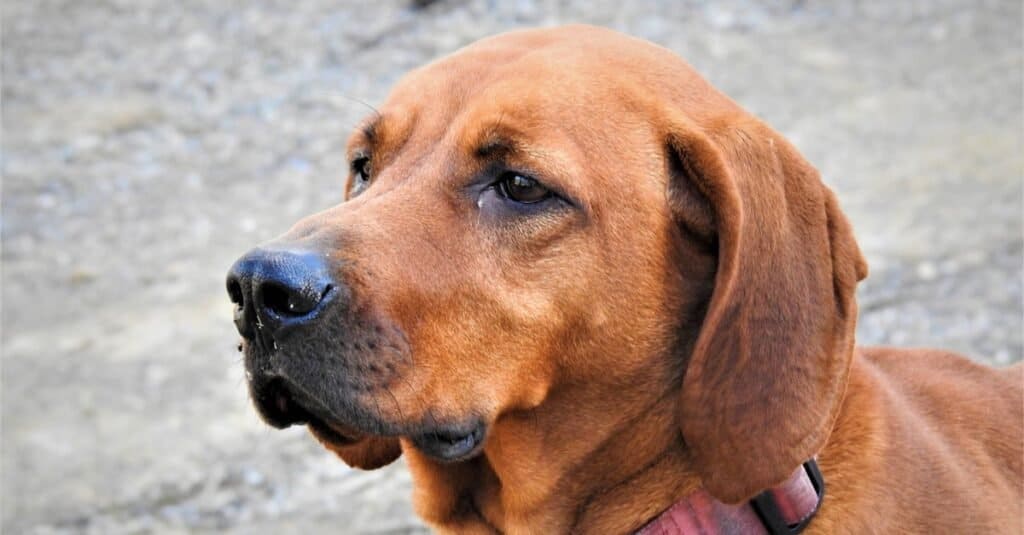
Checking your Redbone Coonhound’s ears weekly for buildup, mites, and ticks are easy ways to avoid ear infections.
©Sierra M Long/Shutterstock.com
Temperament
The love and adoration that families will get from adopting a Redbone Coonhound are almost immeasurable. They are friendly and sensitive, showing their affection to both adults and children alike. They love the mental and physical stimulation that these interactions bring, though their personality sometimes seems to be driven by the need to not be bored. If they don’t get this feedback, their behavior can take a turn for the worst.
Incredibly vocal, their voice can be a sweet tune to take along during hunting season as you trek back with your latest catch. However, since frequent barking is one of their most common traits, it is best to live in an area that won’t be disrupted by their frequent noise.

Redbone Coonhounds love mental and physical stimulation and can be driven by the need to not be bored.
©Crystal Alba/Shutterstock.com
How to Take Care of a Redbone Coonhound
To keep a puppy healthy, the first step is to find a reliable breeder. While rescue dogs are always in need of a home, bringing this pup to a vet and getting genetic testing can give a more precise idea of what to prepare for.
Here are a few more ways that you can make your Redbone Coonhound feel more at home.
The Best Dog Food for Redbone Coonhounds
Since the Redbone Coonhound is prone to obesity, careful attention should be paid to their diet. Some owners have success feeding their dog a freeze-dried raw diet. While one feeding a day should be enough, some dogs like to split the food into two meals. Though cottage cheese, cooked eggs, and fresh produce can be appetizing, it should not cover more than 10% of this dog’s diet.
Drool may be an issue with the Redbone Coonhound. However, the severity of the drool will depend on the shape of their lips, and you’ll probably notice it the most as they gobble up their water. Most often, this pup will start to drool before a meal or if he smells something particularly appetizing in your home, which is called the “Pavlov reflex.”
At A-Z Animals, we think the best dog for Redbone Coonhounds is Diamond Naturals Light Dry Dog Food with Lean Protein.
Your dog will drool over this healthy lamb and rice recipe. There’s ample calcium for building and keeping strong bones and cartilage, with chondroitin sulfate and glucosamine, clinically proven to help dogs’ joints. They’ll love this food, but since it has complete nutrition and lean protein, your Redbone Coonhound may be less likely to overeat and will turn exercise into lean muscle instead.
Try out Diamond Naturals Light Dry Dog Food with Lean Protein, available on Chewy and Amazon.
- Made in the USA using quality ingredients from trusted domestic and global sources.
- Real pasture-raised lamb protein as the #1 ingredient, supports the needs of less active and overweight dogs.
- Omega fatty acids for skin and coat health
- Vitamins and minerals from superfoods, including fruits like blueberries and oranges.
- Includes probiotics, antioxidants and prebiotics to support healthy digestion, immune system health and overall wellness.
- No corn, wheat, artificial flavors or colors.
Maintenance and Grooming
With a short and smooth coat, there’s not much that you’ll have to do to keep Redbone Coonhound groomed. Hounds tend to have their own natural odor, though it won’t bother most owners. Regular bathing can keep this smell under control, but it won’t ever actually go away entirely.
The shortness of the coat gives a distinct advantage to owners that don’t like dog hair everywhere because this breed’s shedding is minimal (at its worst). With twice weekly teeth-brushing sessions and weekly ear cleanings, this dog will stay as fresh as can be.
Training
The ADD-like demeanor of this dog may conflict directly with all of the training efforts that you put in but make no mistake — this training is necessary. Getting them involved with other dogs and their favorite humans helps to socialize them, giving them the feedback that they need to regulate their energy. This dog craves mental stimulation, which is why many owners will turn training into a game. With enough patience, even the most distracted Redbone Coonhound will be a beloved family pet.

Redbone Coonhounds require training and need to regulate their energy.
©Andrea Berg/Shutterstock.com
Exercise
Due to the strong build of the Redbone Coonhound, the best way to keep their behavior under control is to get them out the door for some exercise. They like to go on at least one walk or even a jog each day, though they might run off if left alone in a yard for too long. It isn’t that they are disobedient – they just like to run after anything they might hunt.
While apartment living might work for this pup, they will need to get outside to exercise properly.
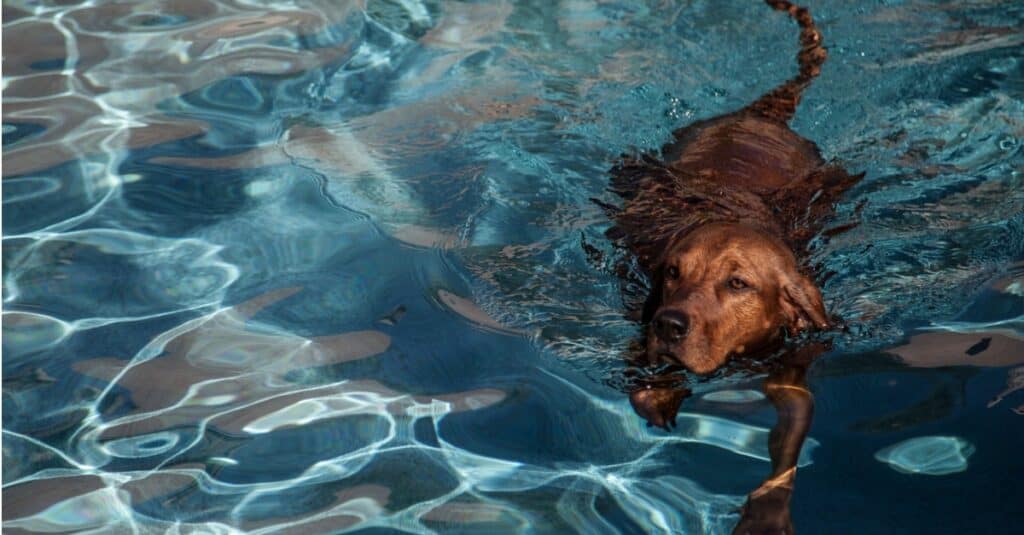
The best way to keep a Redbone Coonhound’s behavior under control is to get them out the door for some exercise.
©iStock.com/videodet
Puppies
When the puppies are under six months old, they’ll need approximately three meals a day. They should not be fed table food to avoid obesity.
Though these dogs get big rapidly, their mental and physical development is slightly delayed. Still, as eager as they can be to please owners, any amount of patience in their training will be greatly appreciated by their typically sensitive nature.
Redbone Coonhounds and Children
Redbone Coonhounds have a phenomenal relationship with children. Their innocent and puppy-like demeanor lasts for years longer than other dogs, and they love to play with their younger household members. While supervision with any dog is necessary for little ones, a little training can make this relationship into a bond that lasts for their entire lifespan. These pups are incredibly loyal, and they’ll do anything to keep the strong bond between their child friends alive.
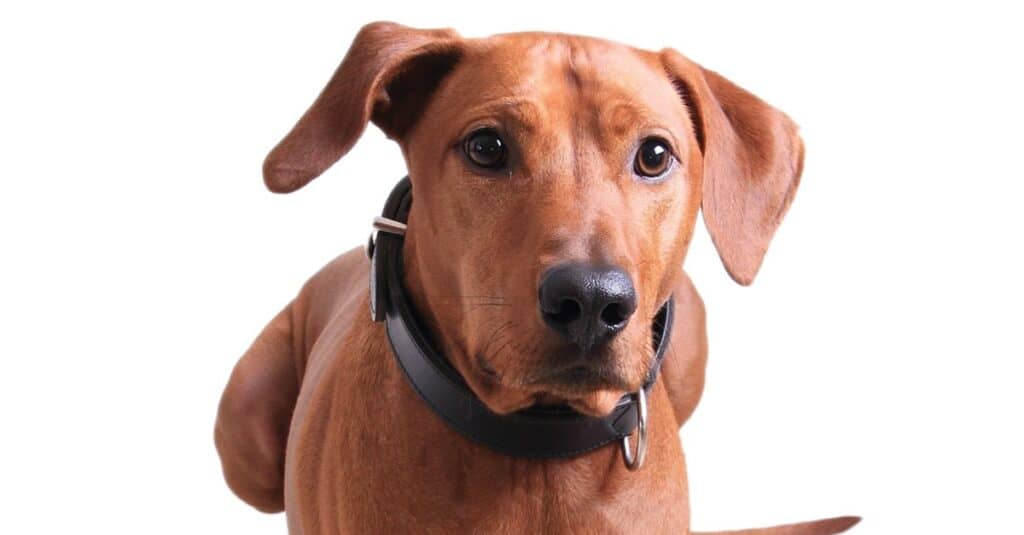
The Redbone Coonhound’s innocent and puppy-like demeanor lasts for years longer than other dogs.
©Tanarot1992/Shutterstock.com
Dogs Similar to the Redbone Coonhounds
As beautiful and wonderful as the Redbone Coonhound can be, it isn’t a good match for everyone. Take a look at these breeds for alternatives to the Redbone Coonhound.
- Bluetick Coonhound – The bluetick coonhound offers the same shorthair and size as the Redbone Coonhound. However, the bluetick coonhound is notable for the many spots and markings on its otherwise black coat.
- Bloodhound – Originally bred to hunt big game, the Bloodhound is slightly larger than the Redbone Coonhound. However, they are much clumsier, and they are best for a home that has young adults (rather than young children or elderly adults).
- Basset Hound – Also a member of the hound family, the Bassett Hound is much shorter but just as sweet. They don’t love to exercise quite as much, but they sure like to indulge in treats whenever (and wherever) they can get them.
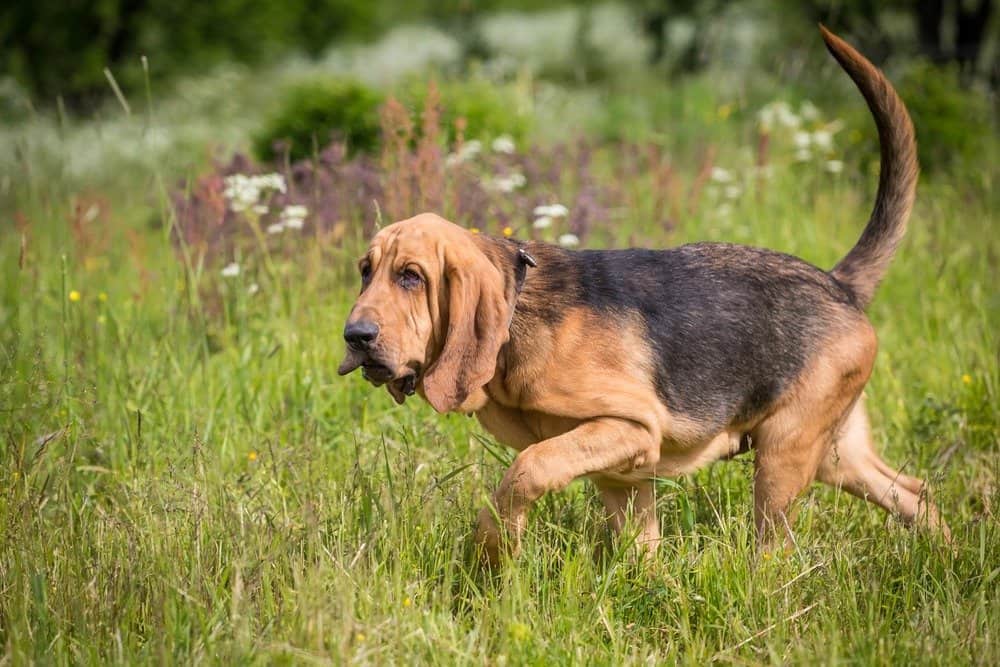
The Bloodhound is slightly larger than the Redbone Coonhound as well as much clumsier.
©Edoma/Shutterstock.com
Famous Redbone Coonhounds
These dogs have been included in books for years, though Where the Red Fern Grows by Wilson Rawls is probably the best place to recall them. Old Dan and Little Ann are title characters, and they even made their way to the big screen when the film adaption premiered in 1974.
Walt Disney Productions has even been responsible for introducing the world to a Redbone Coonhound puppy in The Hound That Thought He Was a Raccoon, which came out in 1960. However, the fact that this breed is often seen as a hunting dog may be why there haven’t been any famous celebrity sightings of the Redbone Coonhound outside of the movies.
Popular Names for Redbone Coonhounds
Some popular names for these dogs include:
- Rosie
- Rusty
- Wilson
- Fawn
- Red.
Redbone Coonhound FAQs (Frequently Asked Questions)
What is a Redbone Coonhound?
A Redbone Coonhound is a dog with a beautiful red coat, complementing their medium-to-large build. This hound is friendly, though they are known for having attention-deficit disorder, so their training can be a little difficult. Their barking is all meant in good fun, and they love the families that they bond with.
Are Redbone Coonhounds good pets?
Absolutely. Redbone Coonhounds love to spend time with their families and will constantly show their affection. With a lifespan of up to 14 years, there’s plenty of time to raise a family around them.
Are Redbone Coonhounds easy to train?
Training a Redbone Coonhound can take a little extra work than other breeds. They are distracted easily, and they need a lot of physical and mental stimulation to be engaged.
Are Redbone Coonhounds aggressive?
Not at all. If anything, this sensitive breed is rather docile. However, it is important to raise the Redbone Coonhound in a loving household since their upbringing can determine their temperament. Adopting from a rescue can result in a less predictable personality, but most of these pups are rather gentle.
How much do Redbone Coonhounds cost?
For a puppy, a Redbone Coonhound can cost $500 to $800. However, adopting from a rescue will drastically reduce the cost.
Thank you for reading! Have some feedback for us? Contact the AZ Animals editorial team.
Sources
- Dogtime / Accessed August 12, 2021
- Dog Breed List / Accessed August 12, 2021
- American Kennel Club / Accessed August 12, 2021
- Embrace Pet Insurance / Accessed August 12, 2021
- Dogster / Accessed August 12, 2021
- Animals Care Tips / Accessed August 12, 2021
- Petolog / Accessed August 12, 2021

